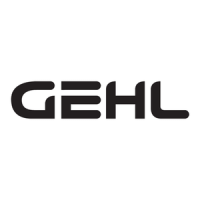
Do you have a question about the Gehl Dynalift 663 and is the answer not in the manual?
Details maximum lift capacity, height, and reach for the machine.
Lists overall length, width, height, ground clearance, and wheelbase dimensions.
Describes gauges and indicators like fuel, hourmeter, and coolant temperature.
Covers steer valve type, pressure, cylinders, and steer modes.
Details service and parking brake types, including hydraulic booster.
Outlines battery, circuit protection, horn, and alternator specifications.
Lists capacities for cooling system, fuel tank, hydraulic system, and transmission.
Describes axle type, differential, and hub capacities.
Details transmission type, speeds, and torque converter.
Lists available engine types, displacement, horsepower, and oil capacity.
Details pump displacement, flow, and relief pressures.
Describes filter media, flow, and pressure ratings for hydraulic filters.
Key inspections and information for machine delivery before customer receipt.
Information to convey to the customer at the time of unit delivery.
Explains the meaning of DANGER, WARNING, and CAUTION symbols.
Step-by-step procedure for safely shutting down the machine before servicing.
Rules for modifying the machine and importance of nameplates and protective guards.
Information on overhead guards, horn, backup alarm, and ROPS.
Identifies the location of indicators and controls within the operator's compartment.
Describes steering modes (2-wheel, 4-wheel, crab) and park brake function.
Explains how to operate the joysticks for frame leveling and boom movement.
Details the operation of the joystick for controlling attachment tilt and rotation.
Recommendations for starting the machine and initial engine break-in procedures.
Step-by-step guide for starting the engine, including warm-up and checks.
Advice on starting the engine in cold weather conditions.
Recommended procedure for safely stopping the machine and shutting down the engine.
Steps for initial operation and understanding the park brake's function.
Procedures for attaching and detaching various tools using the Dynattach system.
Detailed steps for connecting and disconnecting attachment tools using the Dynattach system.
Explanation of the hydraulic self-leveling feature for maintaining attachment tool position.
Daily checks, safe operation practices, and working area inspection.
Guidelines for operating the machine on inclines and slopes, including stability.
Specific grade and slope limitations for operation and load placement.
Procedures for placing loads at different heights and ensuring stability.
Safety rules for suspended loads and requirements for road travel.
Guidelines for transporting the machine between job locations.
Instructions for safely loading and unloading the machine onto trailers using ramps.
Measures to prevent theft and vandalism of the equipment.
Lists recommended lubricants, capacities, and grades for various machine systems.
Part numbers for oil, fuel, hydraulic, and air filters.
Lists and illustrates grease fitting locations for routine lubrication.
General advice on servicing, safety precautions, and authorized service.
Outlines services requiring authorized dealer intervention for major components.
Information on electrical schematics and access points for operator services.
A chart showing component access locations within the operator station, frame, and hoods.
Instructions for checking and draining the fuel tank and filter.
Procedures for checking fluid levels in engine, coolant, transmission, and hydraulic systems.
How to check brake fluid level, park brake tension, and tire pressures.
Checks for instruments, general condition, and overview of maintenance schedules.
Details specific service tasks required at 50, 100, and 250-hour intervals.
Instructions for changing the air filter element.
Steps for cleaning and replacing the air cleaner assembly.
Procedures for checking differential and planetary hub oil levels.
Guidance on when and how to change the fuel filter.
Steps for changing the engine oil and filter.
Information on checking and safely handling the machine's battery.
How to check and adjust alternator and fan belt tension.
Inspecting boom leaf chains and sheaves for wear and proper tension.
Checking boom slide pads for wear, clearance, and proper bolt torque.
Service tasks required at 1000-hour intervals.
Procedures for changing transmission oil and filter.
Steps for draining, flushing, and refilling the radiator coolant.
Instructions for changing the hydraulic return filter element.
Procedures for changing differential and planetary axle oil.
Checking exhaust system and hydraulic system relief pressures.
Steps for preparing the machine for long-term storage.
Recommended checks and actions during the storage period.
Importance of safety decals and procedures for replacement.
Instructions for properly applying new decals to the machine surface.
Information on paint finishes and ordering decal kits.
A chart outlining service procedures and their recommended intervals.
Details what genuine Gehl parts and labor are covered under warranty.
Lists items and conditions not covered by the Gehl warranty.